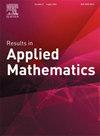Turing patterns across geometries: A proven DSC-ETDRK4 solver from plane to sphere
IF 1.3
Q2 MATHEMATICS, APPLIED
引用次数: 0
Abstract
This paper presents a unified and robust numerical framework that combines the Discrete Singular Convolution (DSC) method for spatial discretization with the Exponential Time Differencing Runge–Kutta (ETDRK4) scheme for temporal integration to solve reaction–diffusion systems. Specifically, we investigate the formation of Turing patterns – such as spots, stripes, and mixed structures – in classical models including the Gray–Scott, Brusselator, and Barrio–Varea–Aragón–Maini (BVAM) systems. The DSC method, employing the regularized Shannon’s delta kernel, delivers spectral-like accuracy in computing spatial derivatives on both regular and curved geometries. Coupled with the fourth-order ETDRK method, this approach enables efficient and stable time integration over long simulations. Importantly, we rigorously establish the necessary theoretical results – including convergence, stability, and consistency theorems, along with their proofs – for the combined DSC-ETDRK4 method when applied to both planar and curved surfaces. We demonstrate the capability of the proposed method to accurately reproduce and analyze complex spatiotemporal patterns on a variety of surfaces, including the plane, sphere, torus, and bumpy geometries. Numerical experiments confirm the method’s versatility, high accuracy, and computational efficiency, making it a powerful tool for the study of pattern formation in reaction–diffusion systems on diverse geometries.
跨几何图形的图灵模式:一个经过验证的DSC-ETDRK4从平面到球体的求解器
本文提出了一个统一的、鲁棒的数值框架,该框架结合了用于空间离散化的离散奇异卷积(DSC)方法和用于时间积分的指数时差龙格-库塔(ETDRK4)格式来求解反应扩散系统。具体来说,我们研究了图灵模式的形成-如斑点,条纹和混合结构-在经典模型中,包括Gray-Scott, Brusselator和Barrio-Varea-Aragón-Maini (BVAM)系统。DSC方法采用正则化香农δ核,在计算规则和弯曲几何的空间导数时提供了类似光谱的精度。与四阶ETDRK方法相结合,该方法可以在长时间模拟中实现高效稳定的时间积分。重要的是,我们严格地建立了必要的理论结果-包括收敛性,稳定性和一致性定理,以及它们的证明-当应用于平面和曲面时,DSC-ETDRK4组合方法。我们证明了所提出的方法能够准确地再现和分析各种表面上的复杂时空模式,包括平面、球体、环面和凹凸几何形状。数值实验证实了该方法的通用性、高精度和计算效率,使其成为研究不同几何形状反应扩散系统模式形成的有力工具。
本文章由计算机程序翻译,如有差异,请以英文原文为准。
求助全文
约1分钟内获得全文
求助全文
来源期刊

Results in Applied Mathematics
Mathematics-Applied Mathematics
CiteScore
3.20
自引率
10.00%
发文量
50
审稿时长
23 days
 求助内容:
求助内容: 应助结果提醒方式:
应助结果提醒方式:


